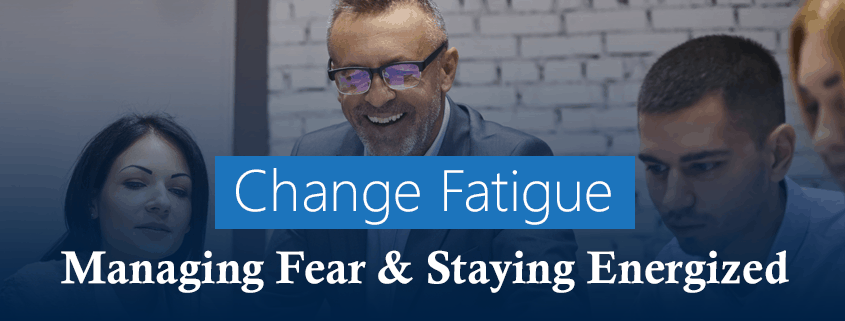Change Fatigue: Managing Fear & Staying Energized
It’s been said that change doesn’t happen overnight but is there a fair deadline to expect demonstrated change? Do you check in with your team and determine if change is happening or if you are in the backslide to the way things used to be? Creating change involves shifting behaviors and creating new habits. When these don’t happen as quickly as you’d like or how you expect, change fatigue can set in.
For many, change is a rough and tumble environment, one where people are uncomfortable and unsure of where their place is. Because of this, companies who start down the change path often retreat for calmer pastures, so to speak. Keep in mind calmer doesn’t always mean better. It means ignoring problems, accepting the status quo, and never doing what it takes to improve and get to the next level.
This resistance to change isn’t uncommon because it’s challenging to stay energized. Change fatigue comes from a combination of several factors including past failures, sacrifices, and rollouts happening slower than anticipated. Facing the mountain head-on is way different than talking about the aspirations to climb it; because of this, you must press onward. Which will your company dare to do? Talk about achieving greatness or being great?
Managing the Fear of Change
It’s likely that people don’t fear change itself but rather the unknown of doing things a different way. That’s why it’s critical to make your mission and plan crystal clear. Create cultural experiences that support the vision. These can include updating processes, introducing new tools, or reorganizing your working space. Actions let your team knows there’s a plan with milestones and deadlines attached.
Change requires the stamina to weather hurdles and setbacks. To power through, you must state the goal repeatedly and focus on why it’s important. More importantly, you need to follow it up with action where people can bear witness to change, as small as the steps may seem at first.
Managing change fatigue requires a constant check to ensure your team is still focused on the vision. Without everyone moving in the same direction toward the same goal, change will never happen. You’ll never feel it click into place.
Staying Energized Throughout the Change Process
Change requires a lot of physical energy, the act of actually putting in the work. It also requires high emotional energy, which people may not have or know how to recharge. Business as usual doesn’t come to a stop because your company is in the midst of a cultural change. Deals still need to be signed, money still needs to be made. How, then, do you stay energized to make the extra effort?
One of the big factors is putting the right people in the leadership role. The people leading your team can energize your teams or zap them dry. It’s the decision between making your efforts worthwhile or starting the process from the beginning again and again. Many companies get in the habit of promoting people based on their skill alone and the amount of work they can produce without taking a good, hard look at their emotional stamina. How do they perform under stress? How well do they balance their work? How much do they energize their teams and those around them? These questions are important with regards to your company leadership but also to your employee retention. High turnover and unengaged employees can stop change initiatives before there’s a chance to begin.
To avoid change fatigue, remember to identify and celebrate early successes, create cultural experiences that support the vision, and focus on the powers of emotional intelligence among your leaders. Honing in on these three areas will help you manage your team’s change fears and keep them focused and energized.




Leave a Reply
Want to join the discussion?Feel free to contribute!